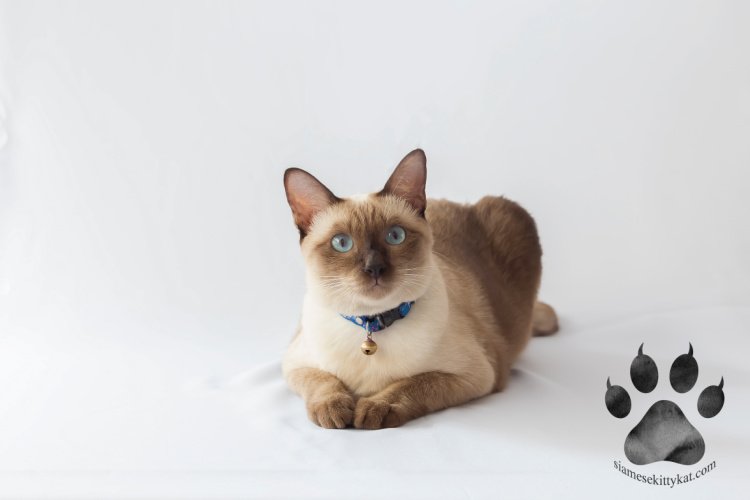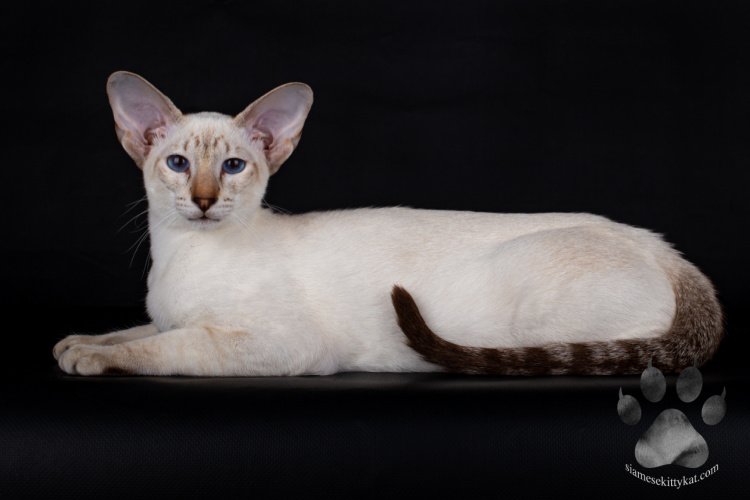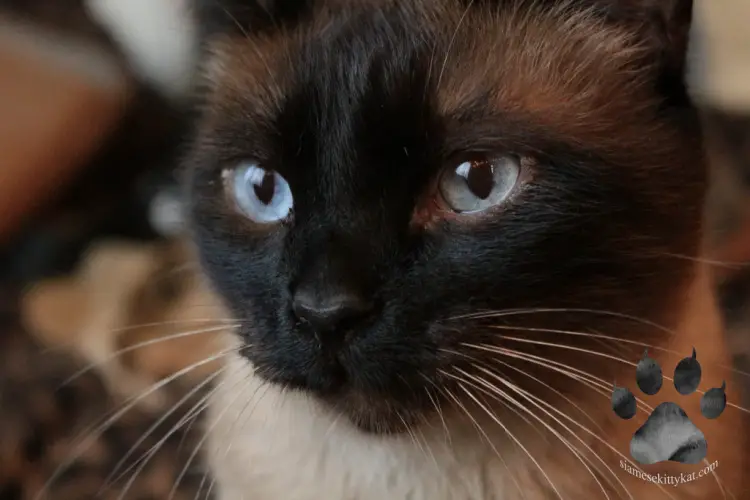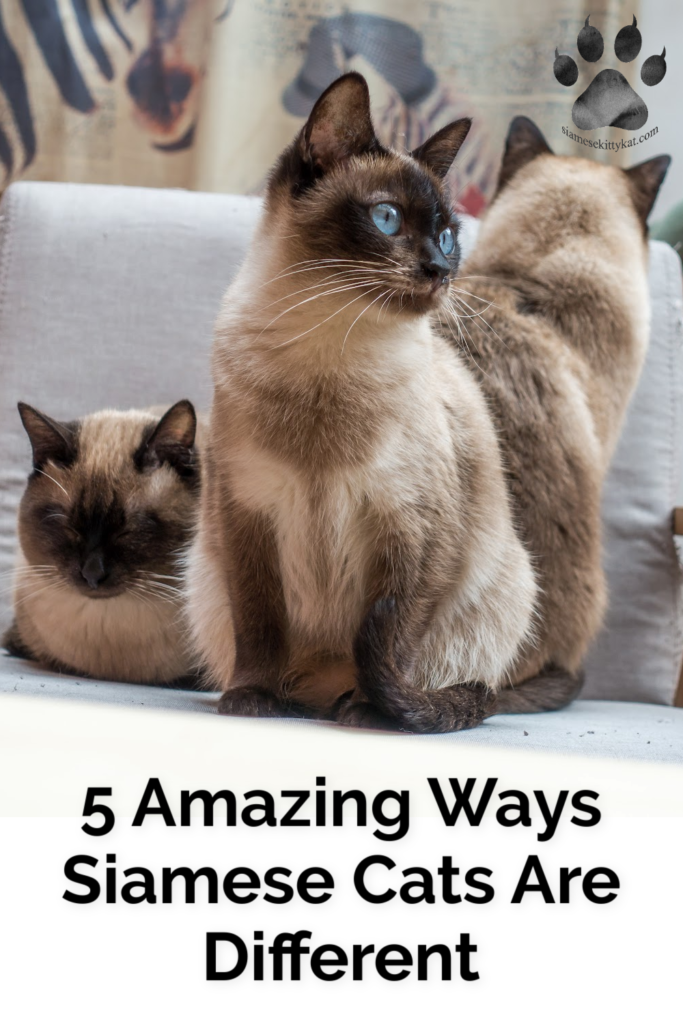Siamese kitties are adored worldwide for their striking blue eyes and unique colored coats. Their long slender bodies sport silvery coats with brown, cream, or even lilac-colored points.
There’s no denying these felines are incredibly pretty, but there is much more to them than their good looks!
For example, did you know that Siamese kitties are more intelligent than your average moggie? Or that they’re born completely white and later develop their colors?
In this article, we’re going to get into everything that makes Siamese cats special. We’ll also discuss what it’s like to own a Siamese, and if these lovable kitties are the right fit for you.
But first, let’s get into the different types of Siamese cats and their personalities.
How many types of Siamese cats are there?
There are actually 9 different types of Siamese cats, however, only 2 are officially recognized. These are modern and traditional Siameses. They are then broken up into subcategories.
1. Traditional Siamese
These Siamese cats have a body shape similar to most domesticated breeds. Their heads are round sporting deep, circular eyes. This is why they’re also referred to as ‘Appleheads.’ Their large triangular ears, however, are very distinct and set them aside from most moggies.
Personality-wise, Traditional Siamese cats adore people and are very friendly. All they want to do is cuddle up on your lap from now until forever.
Sticking with the theme of Siamese cats, these felines are also very vocal. If they want something, believe me, you’ll know about it. They also tend to over-groom, especially if they become stressed.
2. Modern Siamese
These cats have been bred to exaggerate certain features of the Siamese. Along with the triangular-shaped ears, Modern Siamese cats also have triangular heads. This is why they’re often referred to as ‘Wedgies’ or ‘Wedge Heads.’
Their ears and bodies are longer than Traditional Siameses, and their eyes are slanted. They have little fat on their body, so in turn, are muscular and lean.
Wedgeheads rose to popularity in the 1980s, and they’re often the version of the Siamese you’ll find at shows.
They’re just as loving as the Traditional Siamese, and just as noisy too. However, due to cross-breeding, Modern Siamese are much more likely to develop kidney disease.
Some people may argue, however, that there is only one true version of the Siamese – the Modern Siamese. This is down to many breed organizations re-classifying the traditional Siamese as the ‘Thai Cat.’
They can also be referred to as the ‘Old-Style Siamese’ and the ‘Wichien Maat.’
The reason they did that was to put some space between both versions of the Siamese. Even though they originate from the same place, they do look quite different from one another.
3. Classic Siamese
The Classic Siamese was only recognized by breed organizations in 2007, then 2 years later referred to as an ‘advanced new breed.’ These Siamese kitties are the ones you’ll most likely find in most American homes.
Classic Siamese cats have long and sleek bodies, with tails longer than most. They also have the most athletic body shapes, with large, pointy ears and faces.
These felines are the most energetic of all 9 but they are just as loving and affectionate. They yearn for cuddles and are often pushier when it comes to getting the attention they crave.
4. Old-style Siamese
The Old Style Siamese has a lankier body compared to the Modern Siamese and is of medium build. Much like the Classic Siamese, they have large, pointy ears.
People often have a hard time telling the Classic Siamese and the Old Style Siamese apart. Their differences may be small, but the Old Style Siamese has a slightly shorter face with a nose that points straight.
These athletic kitties will follow their owners around and make sure your business is their business. They are less vocal than the Traditional Siamese, but they still have a good set of pipes on them.
5. Seal/Cream Point Siamese

The Cream Point Siamese was the first Siamese variation to find its way into England in the 1880s.
Their base coat is a rich creamy color, while the points on their tail, paws, and face are a darker fawn. These points will become darker over time. The fur on their bellies are usually lighter due to the warmth of their skin, and their nose leather and paw pads are also a dark brown.
These Siameses’ are always born white due to a genetic mutation linked to albinism (but we’ll get into that later!)
6. Blue Point Siamese
A Blue Point Siamese has a very striking blue-white base coat, with some possible shading along their backs. Blue Points tend to darken with age, just like their Cream Point brothers and sisters.
Their color points can either be a bluish-gray or a silvery-blue, found on their face, ears, paws, and tail. Their nose leather and paw pads are gray.
Personality-wise, Blue Points are very warm, loving, and loyal. They love being around their humans every chance they can get.
7. Chocolate Point
Chocolate Point Siamese cats are a part of the Modern Siamese family. They usually have ivory or cream fur with possible shading along the length of their backs.
These color points are quite rare and will have a pale tone until they reach two or three years of age. Their points resemble that of chocolate milk, rich with warm and smooth tones.
The points appear on their face, ears, tail, and paws. The nose leather and paw pads on a Chocolate Point are pink.
When Chocolate points are young, they’re often confused with Seal points due to their cream-colored bodies. It’s not only till later down the line when they begin to develop their colors do the two become distinguishable.
Chocolate points are incredibly friendly, intelligent, energetic, and playful, just like other modern types of Siameses.
8. Lilac Point
Lilac Points were first recognized in the 1960s and are quite rare. They have a very pale cream or white base coat, which makes them the lightest of all Siamese cats. Unlike Cream Point and Blue Points, their coat stays light through their entire lives.
These Siamese kitties are most known for their striking blue eyes, sporting a pinkish-gray or brown color on their faces, paws, ears, and tail. The nose leather and paw pads on a Lilac Point are usually a lilac pink.
9. Red Point
Red Points have yet to earn the ‘Official Siamese Cat’ trophy. Since they’re not a part of the more traditional color set, they’re often not recognized as a point. However, they are becoming increasingly popular among households in the UK and Australia.
Their base color is a creamy white while their points are a mix of orange, dark amber, and crimson. These can be found on their ears, nose, tails, and paws. The nose leather and paw pads of a Red Point Siamese are a soft pink.
Often referred to as the ‘Flame Point’ in the UK, these striking kitties have equally striking blue eyes.
How are Siamese cats different?
Siamese kitties are not like any other feline out there – there’s no doubt about it. They have a reputation for being noisier, loveable, and intelligent than your average moggie.
They’re even referred to as more dog-like than cat-like, making sure their presence is known wherever they go. If you ever adopt a Siamese, be sure there’s no cat quite like yours.
Here are 5 things that make Siamese cats so different:
1. Siamese are the oldest breed out there

Believe it or not, our faithful Siamese is actually one of the first pets in history to be domesticated.
We can’t be too certain of the date, but the first known recording dates back to the 14th century in Thailand. There, they were found in Thai historical manuscripts. This would indeed make them one of the oldest breeds in the entire world.
Back then, Siamese cats were actually called ‘Siam’ by the Thai people who bred and domesticated them. All those centuries ago, the Siam ended up with crossed eyes and a kink in their tail.
It is unsure what the exact reasoning for this is – whether it be a breeding issue or not – but it turns out these features are what make them stand out in modern times.
If you were to ask the old Thai community, however, one or two of them may have some stories to tell you. Old legend has it that the Siamese kitties were entrusted to guard the royal goblet and other shiny treasures.
This may explain why modern-day Siamese cats are so protective of their owners, almost like they see them as treasures. I know first hand how intune Siamese cats are with their surroundings – nothing gets by them unnoticed.
Well, according to the legend, this is the reason why their eyes are crossed; so they can see in every direction all at once! Their kinked tails are the way they are due to constantly being wrapped around the goblet to ensure it never goes missing.
Their keen eye also landed them a role in watching over the sick. When someone was close to dying, a Siam would be placed close in hopes they would collect their spirit and receive their soul.
Then, they would be assorted down to a temple where they would be treated to a life of luxury, as the Thai believed their beloved soul lived on within the Siamese.
Of course, these are old folk tales, and whether you believe them or not is purely your choice. I personally believe there is a reason why Siamese cats walk around as royalty (because maybe they once were!)
Siamese cats were also recorded in a book called “Cat Book Of Poems” written between the 13th century and the 16th century. There they were described as light-colored cats with piercing blue eyes and dark spots on their toes and tails.
In the 1880s, a pair of Seal Point Siamese kitties were gifted to a British consul’s sister. 20 or so years later, they began their takeover of America after gaining regional popularity in London.
Switching to modern-day times, Siam has been renamed Siamese and they’re still as popular as ever. You can find them in many households around the world, and they’re still very much adored in Thailand.
Siamese cats truly have an interesting history! In fact, I got so curious that I actually made an in-depth article about where do Siamese cats actually come from. Check it out by clicking on the link!
2. Siamese cats are albinos
Get this, Siamese cats are essentially temperature-controlled albinos! For anyone who doesn’t know, it would be quite a surprise when their pregnant Siamese gives birth to all-white kittens.
Their wide range of unique colors and markings are not only controlled by their genes, but by temperature too. The reason for this is something called the ‘Himalayan Gene’ which affects the epidermis cells of the Siamese.
When a Siamese is born, they’re forced to leave their mother’s womb, which averages at around 101 degrees F. Because of this heat, the Siamese kitten stays completely white.
Similar to us humans, a Siamese will first become cold on their nose, ears, tail, and paws. These are referred to as ‘points.’ Once these points fall below 98 degrees F, they will begin to develop darker patches.
These colors will be determined by their genes, but the strength is controlled by temperature.
For example, a few winters ago my Siamese went into surgery (don’t worry, he’s fine now!) he had to be shaved along his side for it. The winter was super cold that year and naturally, I didn’t think much of it.
I kept him inside as always and he made a full recovery. It’s not until his fur began to grow back that I noticed a dark patch beginning to form. Turns out, since that bare patch was colder than the rest of his body, it grew back a lot darker.
Funny thing is, I actually took him to the vets since I was worried he may have a skin condition! That was where I first learned about their fascinating genes.
3. Siamese cats are always affectionate
Cats have a reputation for being cold and unloving – but we feline owners know that’s far from the truth.
Siamese kitties are incredibly loving, affectionate, and loyal. They’re known for forming a strong bond with that one special person, and once it’s been made, it’s virtually impossible to break.
If you’re watching the TV, they’ll want to be curled up on your lap. If you’re in the shower, they’ll probably want to join. And your best bet they’ll want to be in bed with you!
Siamese cats also make great family pets. Since they crave attention, they’ll pretty much take it from anyone they can. They’re a little wary of new people, but they’ll always be friendly and polite.
One thing you should be aware of, however, is that Siamese cats can actually develop anxiety and depression if left alone for too long. They’re incredibly social creatures so their demand for attention is very real and not just them being ‘needy.’
If you’re someone who is away from home often, then the Siamese may not be a good fit for you.
4. Siamese are always chatty

There’s a reason why these Chatty Cathys have earned the nickname ‘Meezer.’ Compared to most moggies, they’re definitely loud and proud.
They’re talkative by nature and will meow about everything: the weather, their dinner, their toys, what they did last night while you were sleeping…
While their loud voices are just another form of communication, there are a few other reasons why your Siamese may be crying so much.
Take a look at 3 possible reasons why your Siamese may be meowing:
1. They’re lonely
As I mentioned above, Siamese kitties are incredibly affectionate. They hate to be alone and they want nothing more than to be with you 24 hours a day.
Of course, it’s impossible for us to be with them all the time. But, there is a certain amount of attention they need to ensure they don’t feel lonely.
Once your Siamese feels even a slight hint of neglect, they’ll be meowing your house down until you fix it.
While many people view this behavior as ‘bratty’ or ‘needy’ a lack of attention can cause them to develop depression. As soon as they begin feeling this way, their pleasant chirp will turn into something you really don’t want to hear.
2. They need something
Siamese kitties are super intelligent. Most of the time, their meowing is actually learned behavior. They’ll analyze the best way to get your attention and use that to their advantage.
They know that loud meowing = attention.
If you feed your Siamese on a schedule, you may notice that they begin meowing around dinner time. They know what time it is, so they want to make sure you do too.
If you free-feed your Siamese, they more than likely meow more often than not since they know this is the cue for food.
3. They’re bored
Intelligence also brings boredom. And when a Siamese is bored, they’re also very noisy. If they have nothing better to do, their form of entertainment will be wandering around the house and screaming till they get attention.
It’s important that you take a few minutes (30-40) out of your day to entertain your Siamese. If your kitty still isn’t satisfied, ensure they have enough toys to keep them occupied while you’re busy.
If you fail to stimulate them, you can say bye-bye to your favorite couch!
Other reasons your Siamese may be crying include:
5. Siamese cats are basically dogs
A Siamese is a dog in cats clothing, it’s as simple as that. It’s not only me that has that opinion, many people attest to the fact that their Siamese kitties act more like a dog than their fellow felines.
In fact, that’s one reason why most Siamese cats get along with dogs. Simply click the link for the research I did about the topic.
Many people opt for a cat since they want the company of a pet, but don’t have time for the neediness of a dog. Well, if you don’t have time for a dog, you definitely don’t have time for a Siamese.
They’ll meet you at the front door and follow you around the house like a lost puppy. They’re a handful, but the amount of love you receive in return is definitely worth it!
While you don’t have to walk a cat, the Siamese will definitely not be opposed to it. Just like all cats, Siamese love to be outside and in nature. But due to their terrible street sense, and the fact that they’re often a target of theft, it’s better if they’re kept indoors.
They’re super intelligent, so it won’t take long to teach them how to walk on a lead. They’ll probably play fetch with you if you’re ready to teach them!
Siamese cats are also like dogs in the sense they will never leave you alone. They’ll be waiting outside of the shower as if to say “you’re really doing this without me, huh?”
Is the Siamese cat for me?
Bringing a new pet into your life is a huge change and commitment, so you must know what you’re getting into.
It’s common for people to get hypnotized by Siameses’ striking looks and bright blue eyes. However, they often don’t realize just how much commitment they require.
A Siamese cat is the perfect addition to your family if:
If you don’t have enough time, don’t get a Siamese. It’s as simple as that.
And speaking of toys, there are actually a lot to choose from. But if you can’t decide which toy is the best for your Siamese cat, click this link to see 11 of the best ones I recommend.
What Siamese owners have to say
If you’re still unsure, see what other Siamese parents have to say:
“My Siamese is more loving than any human I know! She is so smart and always knows when to cheer me up when I’m down.”
“I’ve never known any cat-like them. I’ve had cats forever, but as soon as I adopted my Siamese it was like a different animal altogether. It definitely took some time to get used to, but I’m so happy that I brought this little love bug into my life.”
“If you don’t have time, don’t get a Siamese! I made the mistake of adopting a Siamese while I had a full-time job and we both ended up being miserable. Thankfully I had the option to work from home, and once I did, we both became so much happier.”
“Siamese cats are hard work, but I wouldn’t have them any other way. I have 4 and counting!”
Are Siamese cats special?
Siamese cats are the most special kitties you’ll ever meet. From their unique and striking looks, right down to their loud and proud personalities – you’ll never be left bored with one of these felines in your home.
These cats are a huge commitment, so only adopt one if you are truly ready for the responsibility.
Be the Siamese Cat expert you always wish to be! From color points to similar cat breeds, discover everything you need to know about their unique charm and characteristics in our comprehensive guide: Siamese Cat Breed: Types, Color Points and Comparison to Other Cat Breeds
Get your FREE Siamese Cat 2026 Printable Calendar

